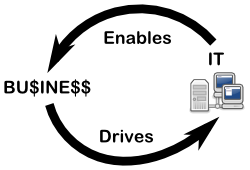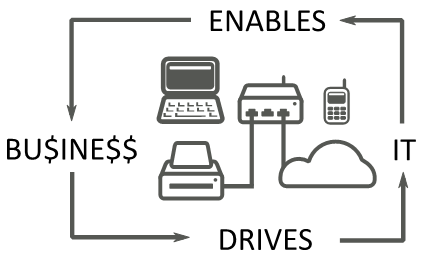Business IT Alignment Tips For Costs Reduction
Most businesses and people use IT daily. It is part of normal life. Many businesses depend on IT to operate and administer the day-to-day running. The buzz phrase for how well the IT systems helps the business is Business IT Alignment.
What is Business IT Alignment?
What is Business IT Alignment? It is the process of changing the IT systems to ensure that they optimally serve the business process, and to make improvements in the business process by using the benefits that IT systems can bring. Here are top ten tips for business IT alignment. Keeping these tips in mind will ultimately reduce the long term running costs of a business.

1. Do not forget the core business.
Improving IT systems is important, but not at the expense of the main business. Make sure the revenue is still coming in and that the day-to-day operation is ticking over. With business operating normally the processes in use are ready for analysis. In one word: Maintain.
2. Plan for the disaster that should never come.
If equipment and software packages are lost they can be replaced. Buying new equipment and software is fine but you cannot buy the business data the organisation has accumulated. Unless it can be recovered from a safe and secure back up location the loss of data could do significant damage to a business. Backup.
3. Keep employees and physical assets safe.
IT kit can be stolen if premises are compromised and staff are targeted. The loss of physical systems and potential employee absence cause by criminal acts can impact the ability of the business to trade. Take measures to track and look after equipment. Invest time in ensuring employees are aware of personal security. Secure.
4. Erect the virtual walls and gates.
Criminals want data and unrestricted access to systems. They want to take over accounts and identities, sell and use confidential data and take control of computers to expand their activities. Don't make it easy. Lock down systems, keep anti-virus solutions and firewalls up-to-date, have effective password procedures and educate employees. Protect.
5. Look at how the business runs and what the IT does and could do.
Run your eyes over the business processes. Talk to the employees to get the detail on the processes. They will know more about the day-to-day operation than the senior managers. There will be steps that take place to aid the daily flow that are not written down anywhere. This analysis clarifies what the IT needs to do and how the processes can be changed for the better. When doing so think evolution rather than revolution. Small incremental changes can be cost effective and not disruptive. Analyse.
6. Rationalize the kit.
Less is more, modern equipment can easily run many tasks, reducing equipment makes the systems streamlined, moving to external systems can provide bigger savings. If employees need to access several systems, or there is a room with lots of servers, think about updating to a single system or cloud solution. Simplify.
7. Reduce manual tasks.
IT is there to help run your business, it can take care of repetitive tasks, it can automate manual tasks, eliminating the need to use paper forms. Machines can be used to take over physical work. Automate.
8.Throw away the duck tape.
Older systems use more energy, can do less for the same energy and are more likely to break down. A modern server can replace several older systems. Web based systems can remove the need for a server altogether. If the computers running the IT creak at the seams it will not be possible to add new processes to them. Renew.
9. Think out of the box.
A successful business is always looking at how it can improve its products and services. How are the competitors running their business? What can the business do to get ahead? Be creative to stand out from the crowd. How much are the employees chained to the desk? Is there an advantage to doing more work on the move? Can employees work from a home office? Innovate.
10. Rinse and repeat.
Business IT alignment is not a one off exercise. It needs to be revisited to keep it as efficient as possible. Always keep points 1 to 4 the top priority, the business needs to run as normal. Perform point 5 from time to time. Markets, products and business changes over time and so the analysis needs to be performed occasionally to take a fresh look at operations. The analysis will lead to applying points 6 to 9 again. Repeat.
With proper management business IT alignment will just be part of normal routine and hardly noticeable. To help remember these 10 tips use the keyword for each of the points above:
- Maintain daily operations.
- Backup company data.
- Secure equipment and access.
- Protect systems boundaries and passwords.
- Analyse business processes and the role of IT.
- Simplify systems and processes.
- Automate manual steps and reduce paperwork.
- Renew old inefficient equipment.
- Innovate what the business does and how it does it.
- Repeat the process from time-to-time to increase efficiency and adapt to change.

See Also
- Time to Change – Rethink How You Spend Your IT Budget.
- For a full list of all the articles in Tek Eye see the full site alphabetical Index.
Published: Updated:







